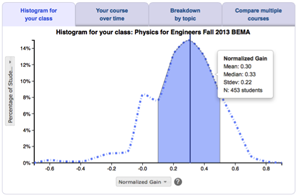Peer Instruction
Essential features
Minimal Implementation:
The following list of essential features was developed by Turpen, Dancy, and Henderson 2010 based on interviews with adopters of Peer Instruction and discussion with Eric Mazur. While this list is considered to be essential by the developers of Peer Instruction, many adopters modify one or more of these features.
- Adapts: Instructor typically adapts how class proceeds based on students’ responses to PI activities.
- Answer not graded: Instructor typically does NOT grade students’ responses to in-class PI questions.
- Commit to answer: Instructor typically gives students a dedicated time to think independently about the question and has students commit to an answer based on their individual thinking. (This feature is commonly modified even by instructors who are experts in PER. See this post on the Peer Instruction blog and the comments on the post for a discussion of this feature.)
- Conceptual questions: Instructor typically uses conceptual questions in-class.
- Conceptual exams: Instructor typically uses some conceptual questions on exams.
- In-class tasks draw on student ideas: Instructor typically has in-class PI tasks draw on common student prior ideas or difficulties.
- Out-of-class assignments: Instructor moves some student work to out-of-class time (e.g., student reading textbook, students study example problem solutions), which allows the instructor to have more flexibility in using class time.
- PI tasks multiple-choice: Instructor typically uses in-class PI tasks which have discrete answer options such as multiple-choice, Yes/No, or True/False (rather than open-ended problems or short-answer questions).
- Questions interspersed: Instructor typically intersperses PI questions throughout the lecture (rather than cordoned off at the beginning or end of class as a separate activity from the “regular” lecture).
- Students discuss: Instructor typically has students discuss their ideas with their peer concerning questions posed in class.
- Vote after discussion: Students typically commit to an answer after discussing the question with their peers.
- Walks around classroom: Instructor typically walks around the classroom during PI activities (possibly talking with students or just listening to student conversations).
Ideal Implementation:
- Motivation: Instructor motivates students by explaining the reasoning and research behind the use of Peer Instruction.
- Participation credit: Instructor offers small amount of credit for responding to questions (regardless of whether they answer correctly).
- Facilitating discussions: Instructor and/or teaching assistants and/or learning assistants help facilitate discussions among students who are not talking or whose discussions are not productive.
- Listening: Instructor listens to student discussions in order to better understand student thinking.
- Whole-class discussion: After students discuss and vote on questions in small groups, instructor facilitates a whole-class discussion in which students share and respond to reasoning for different answers.
- Valuing reasoning: In discussing the solution to a question, instructor emphasizes the reasoning that might lead to different responses in a way that values reasoning over merely getting the correct answer.
- Allowing separation from answers: Instructor elicits student responses using phrases like "Why might someone pick B?", allowing students to discuss incorrect answers without being personally associated with these answers.
- Additional types of questions: In addition to questions designed to elicit and address student difficulties, instructors may use questions with other goals, such as directing attention and raising awareness, promoting articulation and discussion, and stimulating cognitive processes. (Beatty, Gerace, Leonard, and Dufresne 2006)
- Selective use of histogram: Most clicker programs allow the instructor to view the results of the initial vote as a histogram. Instructors can choose to display this histogram to the students before peer discussion, or keep it hidden. If most students chose a single answer, showing the histogram may encourage students to accept the majority answer without thinking it through. However, if the response is evenly split between two or more answers, showing the lack of consensus can help spur discussion. See this post on the Peer Instruction blog and the comments on the post for a discussion of this feature.
References
- I. Beatty, W. Gerace, W. Leonard, and R. Dufresne, Designing effective questions for classroom response system teaching, Am. J. Phys. 74 (1), 31 (2006).
- C. Turpen, M. Dancy, and C. Henderson, Faculty Perspectives On Using Peer Instruction: A National Study, presented at the Physics Education Research Conference 2010, Portland, Oregon, 2010.




